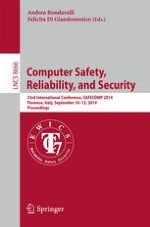This book constitutes the refereed proceedings of the 33nd International Conference on Computer Safety, Reliability, and Security, SAFECOMP 2014, held in Florence, Italy, in September 2014. The 20 revised full papers presented together with 3 practical experience reports were carefully reviewed and selected from 85 submissions. The papers are organized in topical sections on fault injection techniques, verification and validation techniques, automotive systems, coverage models and mitigation techniques, assurance cases and arguments, system analysis, security and trust, notations/languages for safety related aspects, safety and security.
